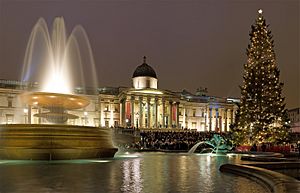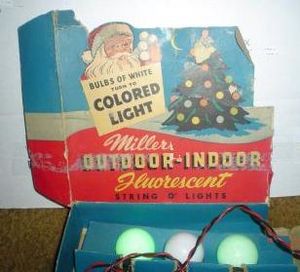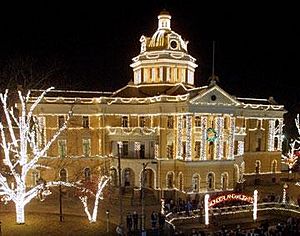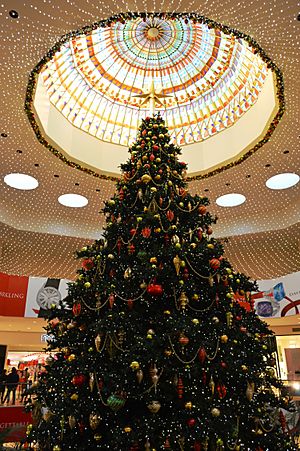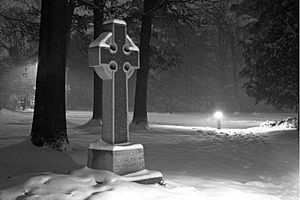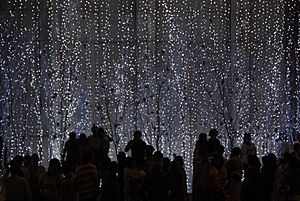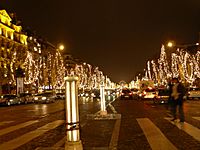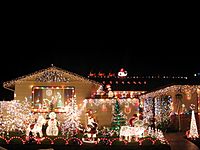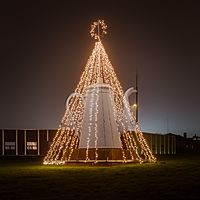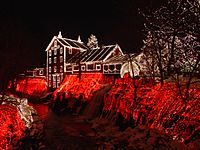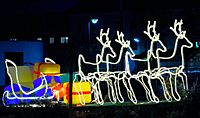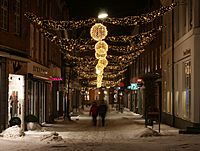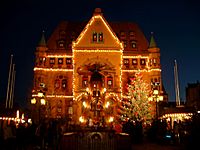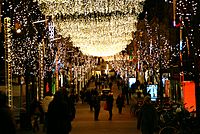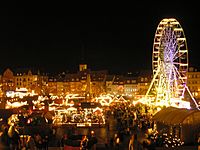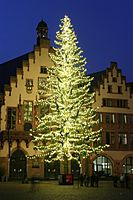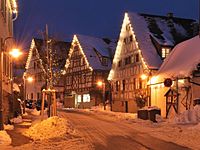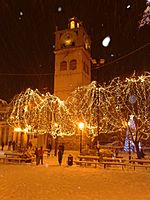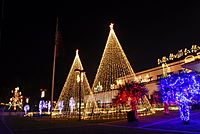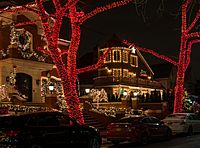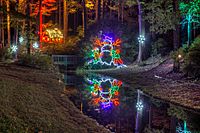Christmas lights facts for kids
Christmas lights are special lights used to decorate homes and streets during the Christmas season. You might also hear them called fairy lights or string lights. This tradition started a long time ago when people decorated Christmas trees with candles. These candles were a symbol of Christ, who Christians believe is the "light of the world." Early Christmas trees were brought into homes by Christians in early modern Germany.
Electric Christmas lights became popular in public places in the early 1900s. By the middle of the 20th century, people started putting strings of lights on streets and buildings, not just on trees. In the United States, it became common for homes to be outlined with Christmas lights starting in the 1960s. This custom then spread to other countries, even outside of Western cultures, like Japan and Hong Kong. Now, it's a worldwide tradition.
Many countries put up Christmas lights and other decorations around the first day of Advent. In Western Christian traditions, Christmas lights are usually taken down on Twelfth Night or Candlemas. Leaving them up longer was historically thought to bring bad luck.
Contents
History of Christmas Lights
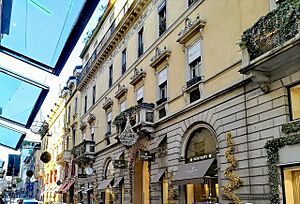
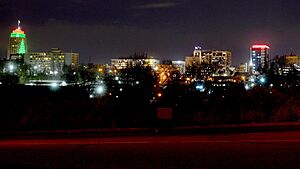
The idea of a Christmas tree became popular in wealthy homes in 18th-century Germany. Sometimes, these trees were decorated with candles. Candles were quite expensive back then. People would glue candles to branches with melted wax or use pins to attach them. Later, special candleholders were invented for Christmas candles around 1890.
Electric Christmas lights first appeared in the 1880s as electricity became more common. The illuminated Christmas tree became popular in the UK during Queen Victoria's time. From there, it spread to North America and Australia. Before electricity was cheap, small candles were widely used.
The very first Christmas tree lit with electric lights was created by Edward H. Johnson. He worked with the famous inventor Thomas Edison. On December 22, 1882, Johnson proudly showed off his tree at his home in New York City. It had 80 small red, white, and blue electric light bulbs. A newspaper in Detroit wrote about it, and Johnson is now known as the "Father of Electric Christmas Tree Lights."
By 1900, businesses started putting Christmas lights in their windows. However, electric lights were still too expensive for most families. It wasn't until around 1930 that electric Christmas lights became common in homes.
In 1895, US President Grover Cleveland had the first electrically-lit Christmas tree in the White House. It was a very large tree with over a hundred colorful lights. The first Christmas tree lamps made for sale came in strings of eight bulbs. They were made by the General Electric Co..
From then on, electric Christmas trees became very popular indoors in the US and other places. The first times Christmas lights were used outside were in San Diego in 1904, Appleton, Wisconsin in 1909, and New York City in 1912. McAdenville, North Carolina claims to have been the first in 1956.
The Library of Congress says that McAdenville started the tradition of decorating outdoor evergreen trees with lights in 1956. The famous Rockefeller Center Christmas Tree had lights since 1931, but real electric lights weren't used until 1956. By the mid-1950s, regular homes started using outdoor Christmas lights.
Christmas lights soon appeared in other places besides trees. By 1919, a city electrician named John Malpiede began decorating Civic Center Park in Denver, Colorado. Soon, lights decorated mantles and doorways inside homes. They also ran along roofs and porches of homes and businesses. Today, many tall city buildings are decorated with long strings of lights. These are often turned on all at once in special "Grand Illumination" ceremonies.
In 1963, people in Greenville, North Carolina decided not to put up Christmas lights. This was a way to protest unfair rules that prevented some people from getting jobs in downtown businesses. This protest was called the "Black Christmas boycott" or "Christmas Sacrifice." It was a strong way to show their feelings.
In 1973, there was an oil shortage. President Nixon asked Americans not to put up Christmas lights to save energy. Many people agreed, and there were fewer light displays that year.
In the mid-2000s, a video of Carson Williams's home became very popular online. He had decorated his house with 250,000 lights that moved to music. This hobby turned into a business for him, and he created huge light displays in shopping centers, parks, and zoos.
How Christmas Lights Work
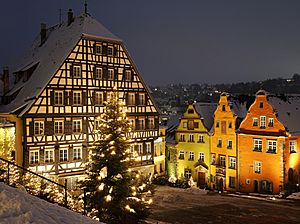
The lights used for Christmas displays come in many different forms. They can be simple strings of lights or complex scenes with moving figures and statues.
Christmas lights (also called twinkle lights or mini lights) are strands of electric lights. They are used to decorate homes, public buildings, and Christmas trees during the Christmas season. These lights come in many different shapes, sizes, and colors. The small "midget" bulbs are sometimes called "Italian lights" in parts of the U.S. because the first miniature Christmas lights were made in Italy.
The types of bulbs used in Christmas lights have changed over time. Older lights used incandescent light bulbs. Today, many lights use light-emitting diodes (LEDs). LEDs are becoming more popular because they use less energy. Some older sets even used neon lamps or fluorescent lamps.
Older Christmas lights with incandescent bulbs could be tricky to fix. If one bulb burned out, the whole string would go dark. Newer mini-lights have a special part called a "shunt." This allows the rest of the lights to stay on even if one bulb fails. However, if many bulbs fail or a shunt breaks, the string can still stop working. There are special tools, like the LightKeeper Pro, that help you find the problem.
When LED Christmas lights first came out, their colors were not very bright. Even the white lights often had a yellowish tint. But LED technology has improved a lot since then!
Outdoor Light Displays
Public Places
Public displays of Christmas lights are a very popular part of the holiday season. Businesses or local governments often set them up. These displays can include huge Christmas trees in town squares, lights on street trees and park trees, and decorations on lampposts. Important buildings like town halls and department stores are also often lit up. Even famous landmarks like the Eiffel Tower and the Sydney Opera House get decorated.
One of the first outdoor public electric light displays was in Altadena, California, on Santa Rosa Avenue. It was called Christmas Tree Lane and has been lit every year since 1920, except during World War II. Famous annual displays in Regent Street and Oxford Street in London started in the 1950s.
Neighborhoods
Outdoor lights for homes became widely available in the 1930s. By the 1960s, it was common for people to outline their homes with weatherproof Christmas lights. The Holiday Trail of Lights in east Texas and northwest Louisiana is a group of cities that started their light festivals a long time ago. Natchitoches began its festival in 1927, making it one of the oldest in the US.
A fun pastime during the holidays is to drive or walk around neighborhoods in the evening to see the lights on homes. Some homes have just a few lights, while others have amazing displays that take weeks to set up. Some of these extreme displays have even been featured on TV shows! They might need a special generator or extra electrical service to power all the lights.
In Australia and New Zealand, Christmas lights were quickly used to light up verandas. People often enjoy cold drinks there on warm summer evenings. Since the late 20th century, Christmas light displays have become more and more detailed. Driving around to see them has become a popular family activity. In some areas, decorating with lights is a big competition, with towns giving awards for the best-decorated house. In other places, it's a team effort where neighbors work together to make their street look amazing.
Today, it's estimated that over 150 million light sets are sold in America each year. More than 80 million homes are decorated with holiday lights. The town of McAdenville, North Carolina is known as Christmas Town USA because the whole town is covered in Christmas lights. Lobethal, South Australia is also famous for its Christmas lights. Many residents put in a lot of effort to have the best display. People from the nearby city of Adelaide often drive there to see them. In the US, the TV show The Great Christmas Light Fight shows homes competing with their amazing Christmas light displays.
Lights for Other Holidays
In the United States, lights are made for many other holidays too. These can be simple strings in holiday colors or lights with plastic ornaments. Light sculptures are also made in the shapes of holiday symbols.
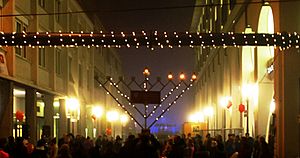
Halloween is very popular for special lights. You can find miniature light strings with black wires and orange bulbs. Some sets even have purple or green bulbs. There are also "icicle lights" in all orange or a mix of purple and green.
Easter lights often come in soft pastel colors. These usually have white wires and connectors.
Red, white, and blue lights are made for Independence Day. You can also find ornaments shaped like the U.S. flag or other patriotic symbols. Some net lights even have a U.S. flag pattern.
Sometimes, these holiday light strings are used on Christmas trees to add more variety to the colors.
Many types of patio lighting are made for summer, without a holiday theme. These often have clear white lights or ornaments like lanterns, flamingos, or palm trees. Some are made of decorative wire in abstract shapes like dragonflies. Light sculptures are also made, from wire-mesh frogs to artificial palm trees outlined in rope lights.
In Pakistan, fairy lights are often used to decorate for Eid ul-Fitr during Chaand Raat, which happens at the end of Ramadan. In India, during Diwali, homes, shops, and streets are decorated with strings of fairy lights.
Environment, Recycling, and Safety
Christmas lights can create recycling challenges. Every year, millions of pounds of old holiday lights are sent to Shijiao, China. This area is known as "the world capital for recycling Christmas lights." It started recycling lights around 1990. In the past, some factories would burn the lights to melt the plastic and get the copper wire, which released harmful fumes. Now, a safer method is used. The lights are chopped into tiny pieces, mixed with water, and then separated. Everything is recycled: copper, brass, plastic, and glass.
More cities in the US are starting programs to recycle Christmas lights. They set up drop-off points where people can bring their old lights.
Old incandescent Christmas lights can sometimes be sold to scrap metal recycling centers. The value comes mainly from the copper inside the wires.
Putting up holiday lights can also be a safety risk. This can happen if you connect too many strands of lights together, use the same extension cords repeatedly, or use an unsafe ladder. Always be careful when decorating!
Light Sculptures
Christmas light sculptures, also called motifs, are used for Christmas and other holidays. Originally, these were large metal frames made for public displays. For example, a city government might place them on utility poles, or shopping centers might put them on lampposts. Since the 1990s, smaller plastic versions are also made for homes. You can hang these in a window, on a door, or on a wall.
Flat sculptures are often on metal frames. Sometimes, garland is added to outdoor motifs. Indoor motifs often have a colorful plastic backing. Three-dimensional sculptures include deer or reindeer in different poses. Some even have a small motor to make their heads move. These 3D displays can be bare frames, or covered with garland, clear plastic cord, or even vines. Snowflakes are a popular design for city displays. They can be left up all winter.
Some places create huge light sculpture displays in December. Examples include Callaway Gardens, Life University, and Lake Lanier Islands in Georgia. In east Tennessee, cities like Chattanooga, Sevierville, Pigeon Forge, and Gatlinburg have light sculptures up all winter. Gatlinburg even has special ones for Valentine's Day and St. Patrick's Day.
Some sculptures have special computer chips called microcontrollers. These chips control the lights so that the object looks like it's moving. This is used for things like falling snowflakes, Santa Claus waving, a peace dove flapping its wings, or train wheels rolling.
Examples of Light Sculptures
-
Christmas market illumination
-
The Dyker Heights neighborhood (nicknamed "Dyker Lights") in Brooklyn, New York
-
Fantasy in Lights at Callaway Gardens
See also
 In Spanish: Luces de Navidad para niños
In Spanish: Luces de Navidad para niños
- Albert Sadacca
- Christmas tree
- Christmas worldwide
- Luminaria
- Parol


